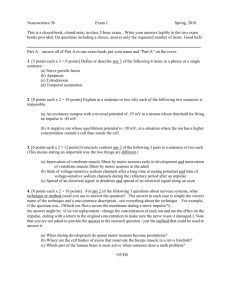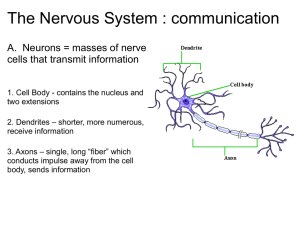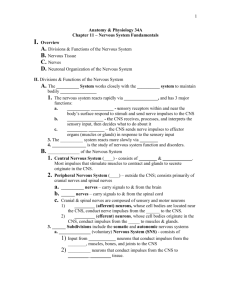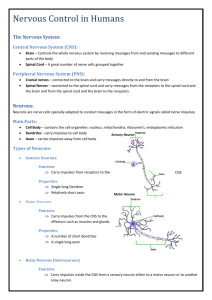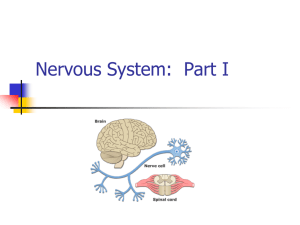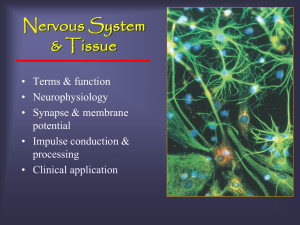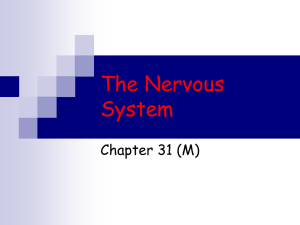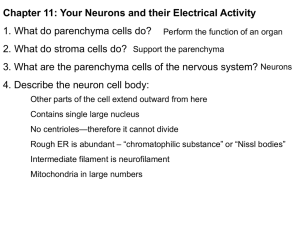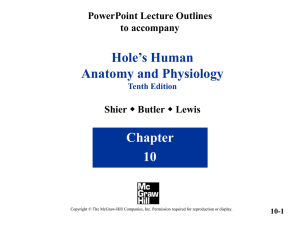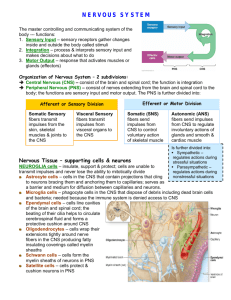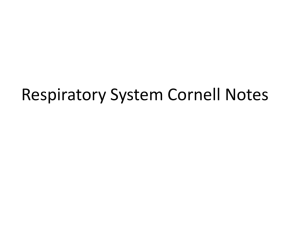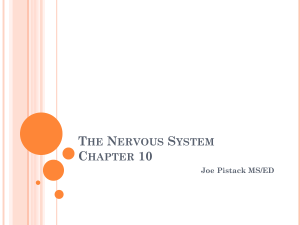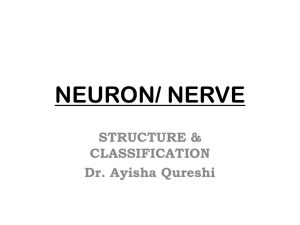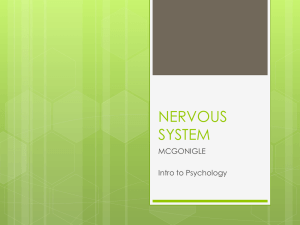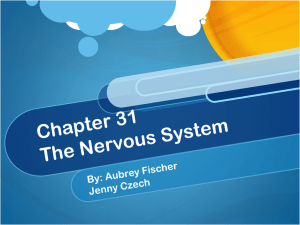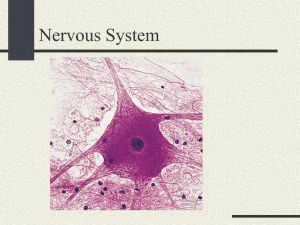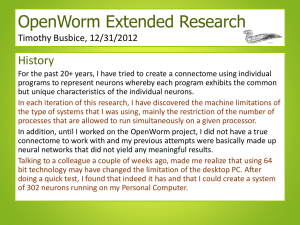File
advertisement
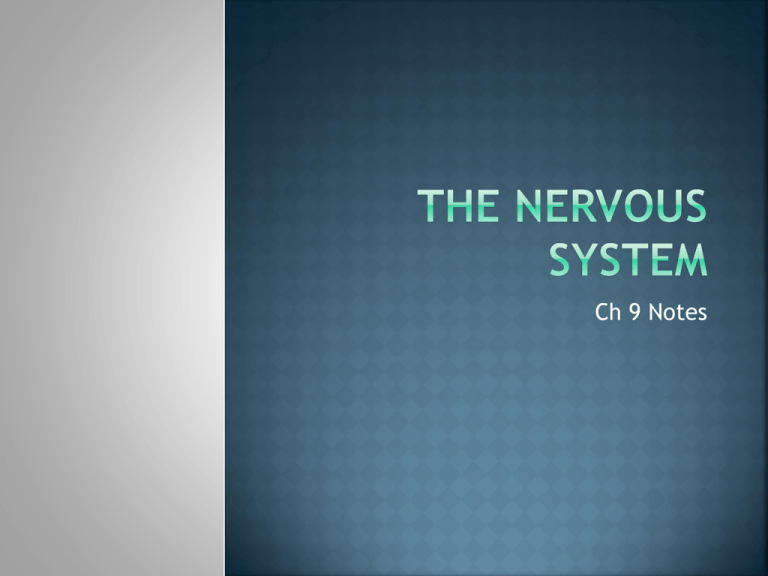
Ch 9 Notes Main Function: Communication Sensory – PNS -> CNS – Noticing a change in the internal or external environment Integration – CNS – Signals brought together in the CNS to create sensation, perception, and make decisions Motor – CNS -> PNS – Relay signals to act on our decisions Effectors = muscles or glands that act on the signal Within the PNS, there are two types of motor neurons Somatic – Voluntary Autonomic - Involuntary CNS Central Nervous System Brain Spinal Cord PNS Peripheral Nervous System Nerves throughout the body that connect to the CNS Neurons Main functional unit Transmit information through electrical impulses Don’t easily divide Neuroglia Provide support, insulation, and nutrients to neurons Easily divide Cell body – contains nucleus Dendrites – receive signals Axons – send signals Structure Pg. 220 Function Pg. 221 Sensory/afferent neurons Association/interneurons Motor/efferent neurons CNS Microglial cells Oligodendrocytes Astrocytes Ependymal Cells PNS Schwann Cells Myelin – an insulator found on some neurons that helps speed up the path of the impulse. Impulse jumps from Node of Ranvier to Node of Ranvier CNS – oligodendrocytes PNS – Schwann cells Nerve “processes” are dendrites and axons. Skeletal System – prominent projection on a bone Where two nerves come together is called a synapse. They do not quite touch each other, but they come very close. The space between is the synaptic cleft. Sender = presynaptic neuron Receiver = postsynaptic neuron Message sending = synaptic transmission Messages go one way Messages are carried by neurotransmitters From axon of presynaptic neuron to dendrite of postsynaptic neuron Muscles = __________ Synaptic vesicles release neurotransmitters into the synaptic cleft Neurotransmitters can excite or inhibit. The overall effect depends on how much of each kind is released. See Table 9.2 on pg 229 Cell membrane is charged – polarized – with respect to the inside due to unequal concentrations of positive and negative ions on either side of the membrane. Action potential – a change in polarization and a return to the resting state This forms a nerve impulse that moves down an axon. Sodium (Na+) and potassium (K+) are important in cell membrane potential. K+ moves out of the cell faster than Na+ can move in. Because more positive ions are moving out than are moving in, the outside of the cell is slightly more positive than the inside (which contains many large, negative ions.) The difference in the charge inside and outside the neuron is called a potential difference. When a nerve cell is at rest, this potential difference is referred to as the resting potential. As long as nothing changes, it will stay this way. An active transport mechanism also aids in maintaining the resting potential by pumping Na+ out and K+ in. Is this cell polarized? What is the potential difference? Is it at resting potential? Is there an indication of an action potential? What would be required for an action potential? Nerve cells are excitable. Respond to stimuli – changes in... Light Temperature Pressure Neurotransmitters Stimuli affect the resting potential of a neuron. The greater the stimuli, the greater the potential change. As the potential difference changes, the cell becomes depolarized. If the depolarization is enough, the membrane potential will reach the threshold stimulus. (about -55 mV) If threshold is reached, an action potential will occur. Remember – action potential occurs when depolarization reaches threshold potential causing a nerve impulse to be pushed down the length of the axon. 1. 2. 3. 4. 5. 6. 7. Threshold stimulus is reached. Sodium channels open. Sodium ions diffuse inward, depolarizing the membrane. Potassium channels open. Potassium diffuses outward, repolarizing the membrane This action potential propagates a wave of action potentials. A nerve impulse moves down the axon. Action Potential in Unmyelinated Axon 1. 2. 3. 4. 5. Stimulus depolarizes the membrane enough to reach threshold potential. Sodium ions rush in through opened channels. Potassium ions rush out through opened channels, repolarizing the membrane. Sodium-potassium pump goes back to work to re-establish resting potential. An impulse of similar reactions is propagated down the axon. Voltage-Gated Channels and the Action Potential There must be a short “resting period” following an action potential where the neuron can’t be stimulated. This is called a refractory period. Two benefits Ensures the impulse moves only in one direction. It limits the frequency of the action potential. Just like with muscle contraction, nerve impulses display an all-or-none response. If threshold potential is reached, the entire neuron responds. Also similar to muscle contraction, all action potentials on one neuron are the same strength. So a stronger stimulation doesn’t create a stronger action potential, it creates more action potentials. Neuronal pools in the CNS take in and put out impulses to other neuronal pools. Neurons or neuronal pools may receive excitatory or inhibitory input. If the input is excitatory, but subthreshold, then it will not create an action potential. The neuron/neuronal pool is, however, more suceptible to reaching threshold, so it is said to be in facilitation. Convergence – When axons originating from different parts of the nervous system lead to the same neuron. Allows you to collect a variety of impulses and act on them appropriately. Divergence – Impulse that leaves one neuron and goes to several other output neurons. Amplifies an impulse so it can move to many different places. Unmyelinated Nerve impulse moves the entire length of the axon. Moves more slowly Myelinated Nerve impulse moves from one node of Ranvier to the next. Moves more quickly. synapse threshold potential neurotransmitter refractory period polarized facilitation resting potential neuronal pools action potential convergence potential difference divergence So far, we’ve spent most of our time talking about neurons – nerve cells. When you bundle a group of neurons together, you get nerves. We call axons “nerve fibers” Sensory fibers/afferent fibers Motor fibers/efferent fibers There are three kinds of nerves: Sensory nerves – conduct impulses to the CNS Motor nerves – conduct impulses from the CNS Mixed nerves – contain both kinds of fibers Nerve pathway – route a nerve impulse follows as it travels through the nervous system. Reflex arc – simplest pathway involving only a few neurons Reflexes – involuntary actions Somatic or autonomic? Reflexes help maintain homeostasis Layered membranes between bones and CNS. Dura mater – outer layer Blood vessels Inside the skull, inward between lobes of brain, and inside the vetebral canal. Arachnoid mater – middle layer No blood vessles Has a subarachnoid space between it and the pia mater which contains CSF (cerebrospinal fluid). Pia mater – innermost layer Blood vessels Very thin and covers brain and spinal cord Continuous with the brain; starts at the foramen magnum. 31 segments each with a pair of spinal nerves. See Fig 9.35 – p 249 Anterior median fissure and posterior median sulcus separate into left and right halves. Sections: cervical enlargement (upper limbs) and lumbar enlargement (lower limbs) Gray matter – looks like a butterfly Posterior horns – upper Anterior horns – lower Lateral horns – middle White matter – separated by gray matter Posterior funiculus Anterior funiculus Lateral funiculus Has bundles of neurons called tracts. Gray comissure surrounds the central canal and contains CSF. Two basic functions Conducting nerve impulses to and from the brain Serving as a center for spinal reflexes Tracts Ascending = carry information to the brain Descending = carry information from the brain Four Regions Cerebrum Diencephalon Brain stem Cerebellum Structure Right and Left Hemispheres Connected by corpus callosum Separated by dura mater Ridges – gyri Grooves – sulcus and fissures Lobes Frontal Parietal Temporal Occipital Cerebral Cortex – gray matter on outer surface. The rest is white matter. Function Sensory area – interpret incoming info; produce feelings/sensations Wernicke’s area – visual and auditory info Association area – analyze, interpret, verbalize, reason, judgement, emotion, concentrating, planning, problem solving... Motor area – Takes info to brainstem and beyond Broca’s area – generates muscle movements for speech. Location: Above midbrain and between cerebral hemispheres. Made mostly of gray matter Parts Thalamus – receives sensory input and channels it to cerebral cortex for interpretation; Produces general sensations of pain, touch, and temp. Hypothalamus – Maintains homeostasis – links nervous and endocrine systems. Regulates temp, blood pressure, hunger and more. Other parts Optic tracts, optic chiasma, infundibulum, posterior pituitary gland, mammillary bodies, pineal gland Also contorls emotional responses through the limbic system. Fear, anger, pleasure, sorrow – can affect actions. Acts as a mechanism to protect the organism to increase the chances of survival. Connects cerebrum to spinal cord. Three parts Midbrain – Connects diencephalon Two corticospinal tracts – main motor pathways between cerebrum and lower parts of N.S. Also has reflex centers Pons – Separates midbrain from medulla oblongata Transmits impulses between M.O. And cerebrum Transmits impulses between cerebrum and cerebellum. Medulla Oblongata – from pons to foramen magnum All ascending and descending fibers pass through Three centers: cardiac, vasomotor, respiratory Reticular formation – Keeps you awake and alert. Two hemispheres connected by vermis. Cerebellar cortex – thin layer of gray matter surrounding the white matter. Three pairs of nerve tracts for communication with CNS – cerebellar peduncles. Sense, integrate, and move body parts. Coordinates movements. complex skeletal muscle Created in the choroid plexus in the pia mater of the ventricles. Travels through other ventricles in the cerebrum and brainstem and into the spinal cord. Completely fills the subarachnoid space which surrounds the brain and spinal cord. Protects organs by absorbing energy that might otherwise damage them. Also maintains homeostasis – ions, blood, wastes, etc. Four lobes Cerebellum Cerebrum Brainstem – all three parts Diencephalon Meninges – distinguish among them Somatic vs Autonomic Cranial nerves vs Spinal nerves Cranial Twelve pairs – Pg 247 Spinal nerves nerves Thirty-one pairs – Pg 249 Most form plexuses – cervical, brachial, lumbosacral



